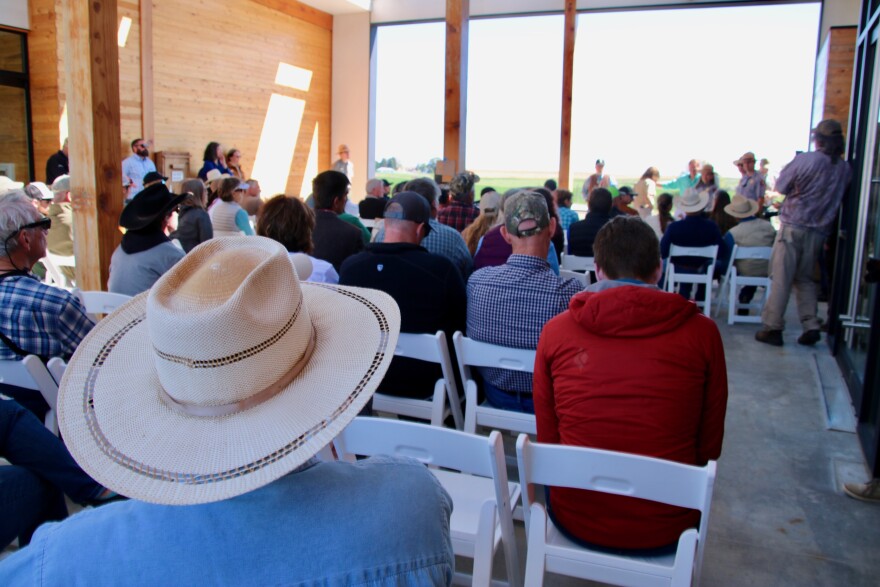It would be the largest wind farm in Idaho, the first renewable energy development on public land in the state and the first onshore wind project permitted anywhere in the country by the Bureau of Land Management during the Biden Administration.
After nearly three years of review under the National Environmental Policy Act (NEPA), the federal government says it plans to publish the final environmental impact statement on the Lava Ridge Wind Project in early June.
The wind farm, located mostly on public lands in Jerome, Lincoln and Minidoka counties, could include up to 400 wind turbines, providing more than 1,000 megawatts of power.
Local opposition to the Lava Ridge has been fierce. Groups ranging from the Japanese American community to wildlife advocates to ranchers have concerns about the turbines’ proximity to the Minidoka National Historic Site, pronghorn migratory routes and existing grazing leases. Letters opposing it were signed by seven local county commissions and received unanimous support in the state legislature.
On the other hand, the Biden Administration says projects like Lava Ridge are key to its goal to phase out fossil fuels from the country’s power sector by 2035 in order to avoid the worst effects of climate change.

The Bureau of Land Management released the draft environmental impact statement on the wind project in January 2023, revealing a preference for project designs with fewer turbines, farther from the Minidoka National Historic Site, where 13,000 Japanese Americans were incarcerated during World War II.
Robyn Achilles, the executive director of the Friends of Minidoka noprofit, said despite the preferred alternatives in the draft EIS, many in the Japanese American community still oppose Lava Ridge and feel the BLM has not listened to their concerns.
“We've provided interviews, we've attended meetings, we provided documentation and cultural reports,” she said, “but they have not made meaningful changes to protect Minidoka despite all of this information we've provided.”
Friends of Minidoka is seeking long-term protections for the viewshed surrounding the historic site, which it says is fundamental to understanding and remembering the somber experience of those incarcerated at Minidoka, and it wants those designations incorporated into the final EIS.
LS Power, the company proposing Lava Ridge, also said it’s made a number of changes to the project, including placing its turbines farther from Minidoka and making a portion of the project’s energy first available to Idaho companies.
The draft EIS generated 11,000 public comments, and the BLM said 4,500 were “substantive” enough to contribute to the final report. It may again select preferred project designs, which could be different from those in the draft version.
Peter Richardson, the executive director of the volunteer-run organization Idaho Energy Freedom, hopes the BLM isn't swayed by widespread "myths" about wind energy propagated by opposition to Lava Ridge.
"They shouldn't be opposed or supported based upon emotion," he said. "They should be supported or opposed based upon the facts."

The controversy over the wind farm was recently featured in federal budget hearings on Capitol Hill, when Sen. Jim Risch (R-Idaho) asked Secretary of the Interior Deb Haaland to name Idahoans in favor of the project. Haaland instead listed the number of meetings the agency has held with tribes, counties and other groups.
“You are not going to commit that you will abandon this, if indeed the situation is that nobody in Idaho wants this?” Risch asked.
“Senator, I appreciate and recognize that you do not like this project,” Haaland said.
“No, no, not me. The people of Idaho do not like this project,” Risch responded.
Michael Gerrard, a professor and director of the Sabin Center for Climate Change Law and Columbia Law School, said it’s important the government takes feedback into account during the environmental review process, and public opinion can play a significant role in the decision making.
“However, it's not a popularity test,” he said. “It's not a poll. And so even if most people in the area are opposed to a project, that doesn't automatically mean it doesn't happen.”
Gerrard said lawsuits are likely to follow the NEPA process for projects with a lot of opposition, which on a broad scale can slow down the energy transition.
“We know that we need a massive amount of wind and solar in order to meet the climate goals,” he said. “We also know that there are a lot of people who are opposed to, not so much the theory of wind and solar, but having it near them.”
Jerome County, which would be home to some of the Lava Ridge turbines, has already indicated it’ll take part in legal action against the project. This spring, county commissioners agreed to dedicate $10,000 to Boise firm Kirton McConkie, which is planning a lawsuit.
“We have a lot of concerns about what they’re planning, and that’s why we’re trying to hit this from every angle,” said Commissioner Ben Crouch. “The next battlefront is in the courts.”
The BLM will issue a final decision on the wind farm at least 30 days after the final environmental impact statement is released.
Find reporter Rachel Cohen on X @racheld_cohen
Copyright 2024 Boise State Public Radio



